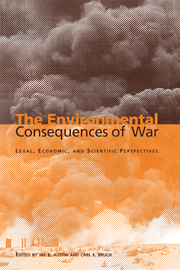Book contents
- Frontmatter
- Contents
- List of illustrations
- List of tables
- List of contributors
- Acknowledgements
- Foreword by Klaus Toepfer
- Introduction
- Part I General principles
- Part II The legal framework
- Part III Assessing the impacts – scientific methods and issues
- Introduction
- 11 Scientific assessment of the long-term environmental consequences of war
- 12 The Gulf War impact on the terrestrial environment of Kuwait: an overview
- 13 War-related damage to the marine environment in the ROPME Sea Area
- 14 War and biodiversity: an assessment of impacts
- Introduction
- 15 Tracking the four horsemen: the public health approach to the impact of war and war-induced environmental destruction in the twentieth century
- 16 Defoliants: the long-term health implications
- 17 The impact of military preparedness and militarism on health and the environment
- 18 War and infectious diseases: international law and the public health consequences of armed conflict
- Part IV Valuing the impacts – economic methods and issues
- Part V Prospects for the future
- Index
11 - Scientific assessment of the long-term environmental consequences of war
Published online by Cambridge University Press: 04 August 2010
- Frontmatter
- Contents
- List of illustrations
- List of tables
- List of contributors
- Acknowledgements
- Foreword by Klaus Toepfer
- Introduction
- Part I General principles
- Part II The legal framework
- Part III Assessing the impacts – scientific methods and issues
- Introduction
- 11 Scientific assessment of the long-term environmental consequences of war
- 12 The Gulf War impact on the terrestrial environment of Kuwait: an overview
- 13 War-related damage to the marine environment in the ROPME Sea Area
- 14 War and biodiversity: an assessment of impacts
- Introduction
- 15 Tracking the four horsemen: the public health approach to the impact of war and war-induced environmental destruction in the twentieth century
- 16 Defoliants: the long-term health implications
- 17 The impact of military preparedness and militarism on health and the environment
- 18 War and infectious diseases: international law and the public health consequences of armed conflict
- Part IV Valuing the impacts – economic methods and issues
- Part V Prospects for the future
- Index
Summary
Introduction
The environmental impacts of wars are almost invariably adverse, regardless of whether they are caused by direct military actions or strategic counteractions, or collateral damages, or are the result of military support activities before or after the war. The total environmental damage caused by a specific war is the result of several factors. These include: the type of war (conventional, biological, chemical, or nuclear); the types of weapons and extent to which they are used; the duration and intensity of the war; the extent and type of terrain over which the war is fought; the strategies used during the war; and the prewar environmental conditions. These factors also affect the duration of the specific environmental impacts. It has been estimated that some 200 armed conflicts have occurred since World War II, mostly in developing countries. These wars have killed more than 20 million people and displaced several millions more, causing serious environmental and economic damages.
Environmental impacts of wars
The environmental impacts of wars are often multi-dimensional. They also often have repercussions in areas long distances away from those of concentrated battle and over prolonged periods of time, long after the wars have ended. Several possible environmental impacts of war are explored below.
IMPACTS on land
Land is affected both by direct war actions and by military operations (preparations for war). Bombs and missiles contribute to the formation of craters, compaction and erosion of soil, and soil contamination by toxic and hazardous residues.
- Type
- Chapter
- Information
- The Environmental Consequences of WarLegal, Economic, and Scientific Perspectives, pp. 303 - 315Publisher: Cambridge University PressPrint publication year: 2000
- 20
- Cited by



